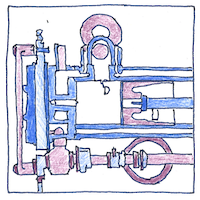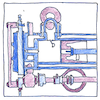Internal combustion engine
Many beginnings many scientists and engineers since cannons are internal combustion engines in 1678 Jean de Hautefeuille proposed using gunpowder to produce a vacuum to pump water and to power the piston of a heat engine
Huygens’ engine
In 1678 and 1679, Christiaan Huygens and Denis Papin designed and built a gunpowder engine that worked by atmospheric pressure acting on a piston in a cylinder vacated by an explosion of gunpowder. Leather tubes let gases escape during the explosion and these were pinched closed when gravity pulled them down. This was before Newcomen’s atmospheric engine which proved steam to be safer than gunpowder.
De Rivaz engine
In 1807, François Isaac de Rivaz built an engine with a single cylinder powered by hydrogen and oxygen ignited with spark from a battery. A piston in a vertical cylinder, raised by the explosion, fell under its weight to engage a ratchet attached to a pulley and move a charette forward. Its fuel, ignition, and exhaust steps were all operated manually.
Pyréolophore
In 1807, Nicéphore and Claude Niépce built an engine powered by explosions of resin and coal dust. They installed it on a boat to suck water at the bow and pump it out the stern. Exhaust in the combustion chamber moved a piston to turn a weighted wheel. Gravity operated on the wheel to power fuel dispenser, bellows, fuse, and valves.
Brown’s gas vacuum engine
In 1826, Samuel Brown converted a Newcomen steam engine to run on hydrogen and power a carriage up Shooter’s Hill in London.
In-cylinder compression
William Barnett’s patent of 1838 described a double-acting, two-stroke engine with the first in-cylinder compression and a pilot light for ignition through an “igniting cock.”
Barsanti-Matteucci engine
By 1854, Eugenio Barsanti and Felice Matteucci built several engines with a single vertical cylinder powered by explosions of hydrogen and oxygen that created a vacuum under a piston. Atmospheric pressure pushed the piston down, engaging a sprocket wheel connected to a drive shaft. In 1858, Barsanti and Matteucci built a counter-working two-piston engine.
Hippomobile and the Lenoir gas engine
In 1859, Étienne Lenoir converted a single-cylinder steam engine to burn coal dust or hydrogen without compression, ignited with a spark generated by an induction coil, the first commercially successful two-stroke internal-combustion engine. * Lenoir’s Hippomobile was a three-wheeled carriage built by Hippolyte Auguste Marinoni (who built rotary printing presses) with Lenoir’s engine slung under the passenger benches powered by petroleum run through a simple carburetor.
Four-stroke engine
In 1861, Alphonse Beau de Rochas designed a four-stroke internal combustion engine, now called the Otto cycle engine, emphasizing the importance of the compression cycle which in compressing the fuel and oxygen mixture improves the efficiency of the engine.
Gasoline engine
In 1876, Nikolaus Otto and Eugen Langen built a successful four-stroke engine that burned coal gas. Otto’s breakthrough was layering the fuel mixture in the cylinder so that it burned progressively instead of explosively. Otto then worked with Franz Rings and Herman Schumm to build the Otto Silent Engine, the first commercially successful engine to use a four-stroke cycle with compression.
ICEd
On electric automobile forums, the expression “the charger was ICEd” describes the situation where a car with an internal combustion engine is parked in a spot reserved for charging.




The Otto Silent Engine didn’t have a spark plug; instead, a slide value in the head admitted the flame of a pilot light to ignite the fuel. It also didn’ have a carburetor, so couldn’t use liquid fuel. Although this was a four-stroke engine, in-cylinder compression and a pilot light were features of William Barnett’s patent thirty-eight years earlier.
See also in The book of science:
Readings in wikipedia:
Other readings: